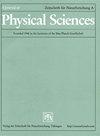Eco-conscious nanofluids: exploring heat transfer performance with graphitic carbon nitride nanoparticles
IF 1.3
4区 物理与天体物理
Q4 CHEMISTRY, PHYSICAL
Zeitschrift Fur Naturforschung Section A-A Journal of Physical Sciences
Pub Date : 2023-10-18
DOI:10.1515/zna-2023-0192
引用次数: 0
Abstract
Abstract The work explores the heat transfer capabilities of semiconducting graphitic carbon nitride (g-C 3 N 4 ) nanofluids. Also, it presents a sustainable and eco-friendly method for synthesizing g-C 3 N 4 nanoparticles using commercially available rice flour as a natural carbon precursor through hydrothermal treatment. The synthesized sample subjected to various characterizations, including analysis of their structure, morphology, thermal properties, and optical properties. The optical bandgap (2.66 eV) is deduced through Tauc plot analysis and reveals the semiconducting nature of the sample. The formation of g-C 3 N 4 is confirmed by various spectroscopic techniques, including X-ray diffraction (XRD), X-ray photoelectron spectroscopy (XPS), Fourier transform infrared (FTIR), and Raman spectroscopy. Thermogravimetric analysis (TGA) demonstrates the nanoparticles’ excellent thermal stability up to 550 °C, indicating potential applications in heat transfer fluids. The investigation of concentration-dependent thermal diffusivity variation using the sensitive mode mismatched dual beam thermal lens technique highlights the potential of g-C 3 N 4 semiconductor nanofluid as an organic and metal-free additive in industry-demanding coolant applications.生态意识纳米流体:探索与石墨氮化碳纳米颗粒的传热性能
摘要:研究了半导体石墨氮化碳纳米流体的传热性能。此外,该研究还提出了一种可持续和环保的方法,利用市售的米粉作为天然碳前驱体,通过水热处理合成g- c3n4纳米颗粒。对合成的样品进行各种表征,包括分析其结构、形貌、热性能和光学性能。通过Tauc图分析,得到了样品的光学带隙(2.66 eV),揭示了样品的半导体性质。通过x射线衍射(XRD)、x射线光电子能谱(XPS)、傅里叶变换红外(FTIR)和拉曼光谱等多种光谱技术证实了g- c3n4的形成。热重分析(TGA)表明,纳米颗粒具有高达550°C的优异热稳定性,表明在传热流体中的潜在应用。利用灵敏模不匹配双光束热透镜技术对浓度相关的热扩散率变化进行了研究,强调了g- c3n4半导体纳米流体作为工业要求苛刻的冷却剂应用中的有机和无金属添加剂的潜力。
本文章由计算机程序翻译,如有差异,请以英文原文为准。
求助全文
约1分钟内获得全文
求助全文
来源期刊
CiteScore
3.00
自引率
5.60%
发文量
81
审稿时长
3.3 months
期刊介绍:
A Journal of Physical Sciences: Zeitschrift für Naturforschung A (ZNA) is an international scientific journal which publishes original research papers from all areas of experimental and theoretical physics. Authors are encouraged to pay particular attention to a clear exposition of their respective subject, addressing a wide readership. In accordance with the name of our journal, which means “Journal for Natural Sciences”, manuscripts submitted to ZNA should have a tangible connection to actual physical phenomena. In particular, we welcome experiment-oriented contributions.

 求助内容:
求助内容: 应助结果提醒方式:
应助结果提醒方式:


